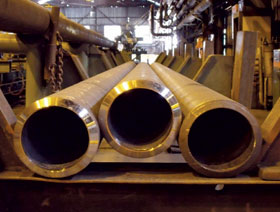

What if you could keep an eye on production in the same way as you monitor your car’s performance? No complicated database retrieval applications no dated and confusing reports, just the KPIs of interest to you on your PC’s desktop in near real-time. Good idea? ArcelorMittal thought so.
At ArcelorMittal’s Vereeniging works, seamless tubes are manufactured and tested in accordance with API standards and meet the requirements of the petrochemical oil and gas industries. Tubes are manufactured via a mini-mill, incorporating a multi-stand pipe mill and in-line downstream finishing facility. The manufacturing facility consists of a rotary hearth furnace, a cone-type rotary piercer and a multi-stand pipe mill. In addition it has a 22-stand stretch reducer followed by two straighteners, cutting and bevelling facilities, as well as an EMI and ultrasonic testing unit.
Forge products includes an extensive range in sizes from 90 to 1 400 mm. The Vereeniging plant produces rounds, squares, flats, thick-wall tubes, step-forgings, rings, disks and blocks. Products are supplied in the ‘as-forged’ condition or heat-treated to specification. Extensive machining facilities are available.
At the Vaal melt shop, sorted scrap metal and ferrous alloys are melted in an electric arc furnace and cast into billets in a continuous process.
“Management wanted constant visibility of critical areas in both the tubular products plant and the melt shop,” says Joao Bordalo, senior architect, MES demand CoE, ArcelorMittal South Africa. “The manufacturing processes at both these facilities are lengthy and complex, requiring constant supervision and it is vitally important to know such KPIs as yields, what is running and what is shut down, how long has equipment been idle and many other factors.”
In order to shorten the time it would take to deploy such a solution, management wanted an off-the-shelf product that could be easily configured and maintained and that would run on the current ArcelorMittal operating system (Windows 7).
“We were already running a suite of Wonderware solutions including a 5000-tag Historian, Historian Client and ArchestrA’s Industrial Application Server,” says Bordalo. “It made sense to choose Factory Widgets from Software Toolbox which is supplied and supported locally by Wonderware Southern Africa. So we bought two Widget Servers and 100 Widget licences. We would run Factory Widgets in conjunction with a GUI solution we developed in-house.”
In this context, Widgets are icons that are displayed on computer desktop screens and that show user-defined KPIs or other information in near real-time. Factory Widgets delivers easy-to-read, near real-time information such as production rates, energy usage, goal progress, yield, safety, lab results, quality level and asset utilisation.
Implementation
“The Widget Servers are installed on the Wonderware Historians and any number of Widgets can be assigned to a server,” says Bordalo. “Also, the time interval for scanning can be set but if all the sources must be scanned every few seconds, this can tie down resources and that is why we chose to install two Widget Servers – one for tubes and the other for the melt shop.”
The software was installed according to the ArchestrA Base Object Derivation standards (Base Master Application – S88). Once Factory Widgets was installed, it was necessary to define the relevant data sources followed by the tags within those sources. The tags are stored in the Historian in order to be accessed by the Widgets. Next was the graphical definition of the Widgets which are stored on the server as global variables. It’s also possible to track which person and computer is using which Widgets.
Benefits
* Factory Widgets allowed ArcelorMittal to leverage existing technology and standardised environment (Wonderware).
* Contributes to plant operations through near-real-time plant status and KPI information.
* Accurate and dependable information improves the speed and confidence of making decisions.
* KPIs are constantly available at a glance.
Conclusion
“Process control information systems are a company’s strategic assets. They need reliable and flexible ways of populating their databases correctly and in that regard, ArchestrA is a powerful system technology that fully supports our company strategy. Factory Widgets leverage this technology and add value by collating and displaying accurate near real-time information on desktops – just where it should be,” concludes Bordalo.
Award winner
At Wonderware’s User Conference held at Sun City in April, Joao Bordalo received the Innovation award for his implementation of Factory Widgets at ArcelorMittal’s Vereeniging Works.
For more information contact Jaco Markwat, Invensys Operations Management, +27 (0)11 607 8100, tech@invensys.co.za, www.iom.invensys.co.za
© Technews Publishing (Pty) Ltd | All Rights Reserved